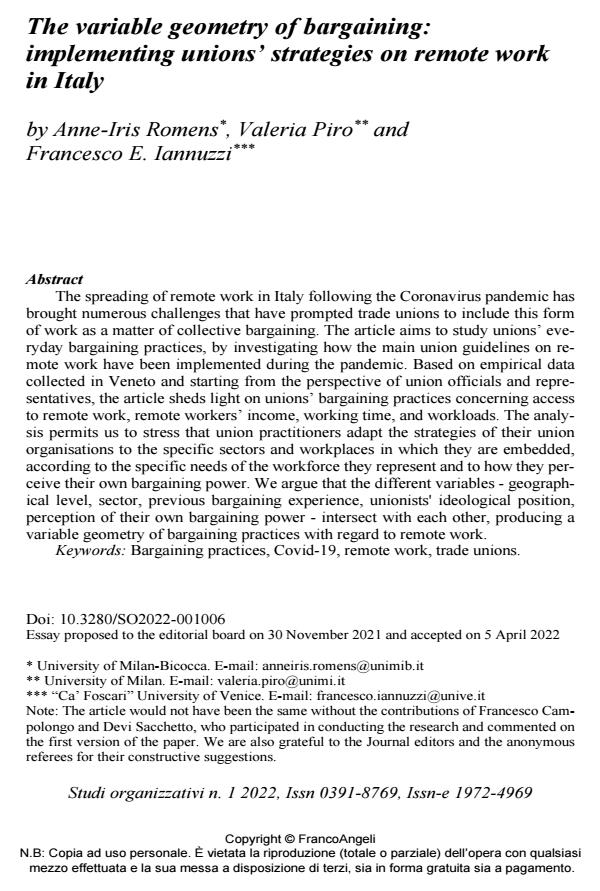The variable geometry of bargaining: implementing unions’ strategies on remote work in Italy
Journal title STUDI ORGANIZZATIVI
Author/s Anne-Iris Romens, Valeria Piro, Francesco E. Iannuzzi
Publishing Year 2022 Issue 2022/1
Language English Pages 25 P. 129-153 File size 260 KB
DOI 10.3280/SO2022-001006
DOI is like a bar code for intellectual property: to have more infomation
click here
Below, you can see the article first page
If you want to buy this article in PDF format, you can do it, following the instructions to buy download credits

FrancoAngeli is member of Publishers International Linking Association, Inc (PILA), a not-for-profit association which run the CrossRef service enabling links to and from online scholarly content.
The spreading of remote work in Italy following the Coronavirus pandemic has brought numerous challenges that have prompted trade unions to include this form of work as a matter of collective bargaining. The article aims to study unions’ everyday bargaining practices, by investigating how the main union guide-lines on remote work have been implemented during the pandemic. Based on empirical data collected in Veneto and starting from the perspective of union officials and representatives, the article sheds light on unions’ bargaining practices concerning access to remote work, remote workers’ income, working time, and workloads. The analysis permits us to stress that union practitioners adapt the strategies of their union organisations to the specific sectors and workplaces in which they are embedded, according to the specific needs of the workforce they represent and to how they perceive their own bargaining power. We argue that the different variables - geographical level, sector, previous bargaining experience, unionists' ideological position, perception of their own bargaining power - intersect with each other, producing a variable geometry of bargaining practices with regard to remote work.
Keywords: Bargaining practices, Covid-19, remote work, trade unions.
- Diversity and Inclusion in Italy Anna Carreri, pp.685 (ISBN:978-3-031-81937-7)
- Labour, unions and R&D in Italian firms Armanda Cetrulo, Valeria Cirillo, Fabio Landini, in Structural Change and Economic Dynamics /2025 pp.262
DOI: 10.1016/j.strueco.2025.01.004
Anne-Iris Romens, Valeria Piro, Francesco E. Iannuzzi, The variable geometry of bargaining: implementing unions’ strategies on remote work in Italy in "STUDI ORGANIZZATIVI " 1/2022, pp 129-153, DOI: 10.3280/SO2022-001006